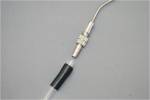 As with conventional hearing instruments, performing a general listening check on a bone anchored hearing aid (BAHA) represents an essential task for assessing whether the device may be working properly. Unfortunately, performing a quick listening check on a BAHA has not been as straightforward as performing the same task on a conventional hearing instrument. A new product distributed by Oaktree Products in St. Louis provides a means for caregivers of BAHA patients to acoustically assess the integrity of the BAHA sound processor.
As with conventional hearing instruments, performing a general listening check on a bone anchored hearing aid (BAHA) represents an essential task for assessing whether the device may be working properly. Unfortunately, performing a quick listening check on a BAHA has not been as straightforward as performing the same task on a conventional hearing instrument. A new product distributed by Oaktree Products in St. Louis provides a means for caregivers of BAHA patients to acoustically assess the integrity of the BAHA sound processor.
 The BAHA Listener, shown at the right, is comprised of several components including a BAHA mount, a battery-operated amplifier (Crescendo 50 amplifier with two AA Alkaline batteries), and a pair of headphones. Both the BAHA mount and headphones plug into the corresponding sockets of the amplifier. All three components are housed in a metal briefcase with foam cut outs for each item. To perform a listening check on a BAHA speech processor, remove the BAHA mount out of the case and position on a flat surface. As shown in
The BAHA Listener, shown at the right, is comprised of several components including a BAHA mount, a battery-operated amplifier (Crescendo 50 amplifier with two AA Alkaline batteries), and a pair of headphones. Both the BAHA mount and headphones plug into the corresponding sockets of the amplifier. All three components are housed in a metal briefcase with foam cut outs for each item. To perform a listening check on a BAHA speech processor, remove the BAHA mount out of the case and position on a flat surface. As shown in  the image to the left, attach the BAHA processor to the top of the mount. Turn the amplifier on and listen through the headphones to determine if the sound heard via the headphones is consistent and clear. If a significant change of sound is noticed, the product packaging instructs the caregiver or parent of the BAHA user to contact their audiologist. This product may also come in handy for audiologist to have at the clinic as an alternative tool for performing quick listening checks on BAHA sound processors.
the image to the left, attach the BAHA processor to the top of the mount. Turn the amplifier on and listen through the headphones to determine if the sound heard via the headphones is consistent and clear. If a significant change of sound is noticed, the product packaging instructs the caregiver or parent of the BAHA user to contact their audiologist. This product may also come in handy for audiologist to have at the clinic as an alternative tool for performing quick listening checks on BAHA sound processors.






























